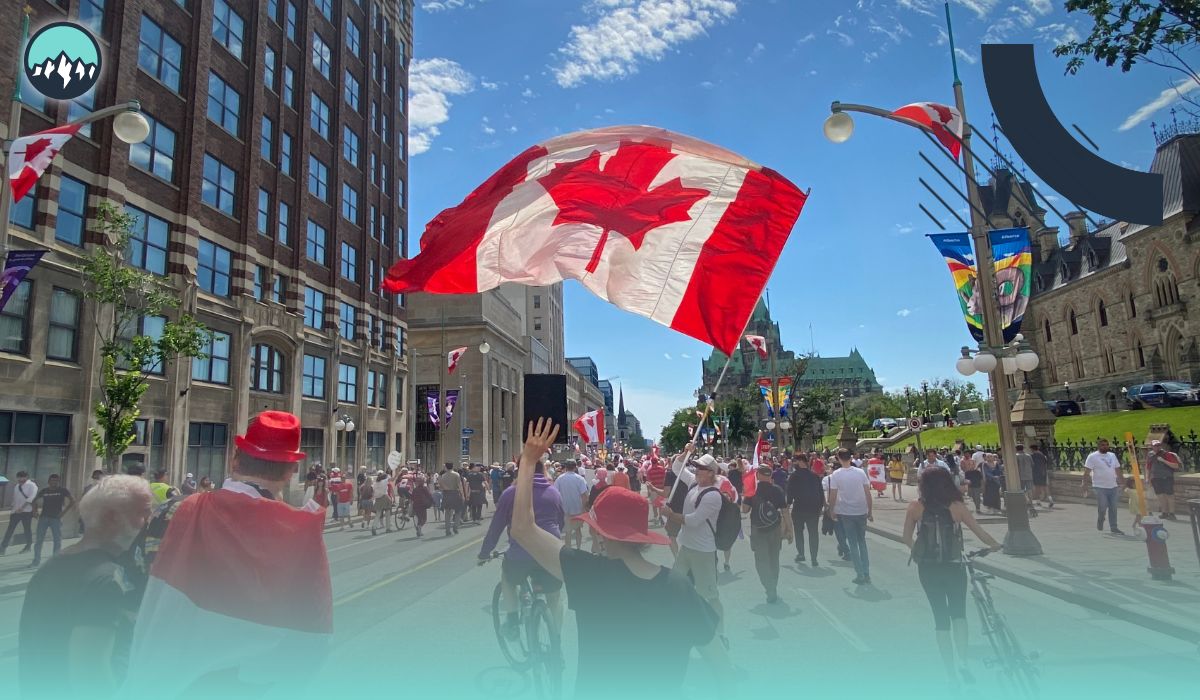The Newcomer's Guide to Weather in Canada
05 Feb 2025

If you’re planning to move to Canada, you’re likely considering various factors such as employment, housing, healthcare, and lifestyle. But one element that’s just as important to consider is Canada’s weather. With its vast expanse and diverse climates, the weather in Canada can vary dramatically depending on the region. Understanding what to expect and how to prepare will make your transition to living in Canada much easier. This comprehensive guide will break down the different seasons, regions, and weather patterns to give you a better understanding of what to expect when you settle in Canada.
The Climate Diversity of Canada
Canada is a country that spans a huge area, and because of its size, it experiences a wide range of climates. Whether you're moving to one of the more temperate coastal cities like Vancouver, or planning to settle in the coldest parts of northern Canada, the climate will have a big impact on your daily life.
The Great White North experiences four distinct seasons - winter, spring, summer, and fall. These seasons bring unique weather patterns and characteristics that you’ll need to adjust to as you settle into life as a newcomer in Canada.
When moving to Canada, it's important to understand the local climate in the area you plan to live in. Each province has a unique climate, which means your experience living in Canada will be vastly different depending on the region.
Winter in Canada

For most of Canada, winter is the longest and harshest season. Whether you’re moving to the prairies, the Great Lakes, or the northern territories, cold temperatures, heavy snow, and icy winds will be a regular feature of your winter months.
- Ontario and Quebec: Cities like Toronto, Ottawa, and Montreal experience cold winters, with temperatures often dipping below freezing. Snowfall can be heavy, especially in the eastern regions, and it’s not uncommon for temperatures to plummet well below -20°C (-4°F) in January and February.
- Western Canada: Vancouver has a relatively mild winter compared to the rest of Canada, thanks to its coastal location. However, expect rain rather than snow. In the interior of British Columbia, winters are much colder, and snow can accumulate quickly.
- Northern Canada: The northern territories of Yukon, Northwest Territories, and Nunavut experience some of the coldest winters in the world. Temperatures can easily fall below -40°C (-40°F), and blizzards are common. Be prepared for snowstorms and long stretches of darkness.
How to Prepare for Canadian Winters
Winter preparation is key for newcomers to Canada. Here’s how you can get ready for the cold:
- Quality winter clothing, including thermal coats, insulated gloves, scarves, and boots are a must.
- Understand how to drive in snow and ice if you’ll be operating a vehicle.
- Be prepared for longer commute times due to snow accumulation on roads.
- Ensure your home is well-heated and insulated to keep out the chill.
Spring in Canada
Spring is a welcome relief after the harsh Canadian winter. This season, which runs from March to May, brings a mix of unpredictable weather. Some days may feel like winter, while others will give a hint of the upcoming summer warmth.
- Southern Canada: In cities like Toronto and Montreal, the weather starts to warm up, with temperatures gradually rising above freezing. Rain showers are common, and you might still experience the occasional snowfall in early spring.
- Western Canada: Spring in Vancouver is relatively mild, but expect rainy days to dominate the season. The west coast tends to be warmer than the rest of Canada, but the rain is something to prepare for.
- Northern Canada: Spring is short-lived in the northern territories. The snow starts to melt, but temperatures can still be quite chilly, and the weather can fluctuate frequently.
Tips for Spring in Canada
Springtime in Canada can be unpredictable. Be prepared by:
- Layering your clothing so you can easily adjust to temperature changes.
- Keeping an umbrella handy to deal with the frequent rain.
- Taking advantage of the melting snow and exploring the great outdoors as temperatures warm up.
Summer in Canada
Summers in Canada, from June to August, are typically warm, though the intensity of the heat can vary greatly from one region to another. For newcomers to Canada, summer is an excellent time to enjoy outdoor activities and explore the country.
- Southern Canada: Summer is warm in cities like Toronto and Montreal, with temperatures regularly climbing into the 20s and even exceeding 30°C (86°F). Humidity levels can also rise, especially in the central and eastern provinces.
- Western Canada: Vancouver and the surrounding areas are known for their mild summers, with temperatures hovering around 20°C (68°F). This makes Vancouver one of the most pleasant cities to live in during the summer, though there can still be occasional heatwaves.
- Northern Canada: The northern territories experience cooler summers, with temperatures reaching only the mid-teens to low 20s Celsius (60s to 70s °F). But this is still a fantastic time to visit the rugged wilderness and take in the stunning scenery.
How to Enjoy Summer in Canada
To make the most of Canadian summers:
- Dress in light clothing, but keep a jacket on hand for cooler evenings.
- Take part in outdoor activities like hiking, biking, and exploring the numerous parks and lakes across the country.
- Prepare for the occasional heatwave with sunscreen, water bottles, and protective gear.
Fall in Canada
Fall, from September to November, is a beautiful time to experience the transformation of Canada’s landscapes. As the temperatures start to drop, the colors of the trees change, creating a stunning visual display.
- Southern Canada: Fall is mild in southern provinces like Ontario and Quebec, but temperatures gradually decrease. Expect cooler days and chilly nights, with occasional rain showers and early frosts toward the end of the season.
- Western Canada: Vancouver and nearby cities experience relatively mild falls, although the rain intensifies in preparation for winter. The west coast offers beautiful fall foliage and fewer snowstorms.
- Northern Canada: Fall comes quickly in the northern territories, with early snowfalls and freezing temperatures in the late autumn months.
What to Expect in Fall
Fall in Canada is a season of transition, bringing cooler temperatures, vibrant foliage, and a shift toward winter. As a newcomer, here’s what you can expect during this beautiful time of year:
- Layer your clothing for warmth during the day, as temperatures can fluctuate.
- Prepare for shorter days and less sunlight as winter approaches.
- Take the opportunity to enjoy the breathtaking fall colors in Canada’s forests and parks.
Regional Differences: Weather Across Canadian Provinces

Each province and territory in Canada has its own unique weather patterns. Here’s a quick overview of what you can expect based on the region where you plan to settle.
British Columbia: Mild Coastal Weather
The west coast, particularly Vancouver, experiences a temperate climate with mild winters and relatively dry, warm summers. The interior of the province, however, experiences colder temperatures and heavier snowfall, making it ideal for winter sports enthusiasts.
Ontario and Quebec: Extreme Seasonal Changes
Ontario and Quebec feature cold winters and hot, humid summers. Cities like Toronto and Montreal experience significant seasonal fluctuations, with snowy winters and sweltering summers.
Alberta: Cold Winters, Warm Summers
In Alberta, cities like Calgary and Edmonton face cold winters but enjoy warm, sunny summers. Alberta also offers fantastic skiing in the winter and beautiful hiking trails in the summer.
Atlantic Canada: A Mix of Coastal and Continental Weather
Provinces like Nova Scotia and New Brunswick have milder winters compared to other regions but are prone to coastal storms. Expect snow, rain, and mild temperatures throughout the year.
Surviving Coldest Months in Canada

Surviving and thriving during Canada’s coldest months requires proper preparation. Whether you are new to the country or experiencing your first winter in a colder province, these tips will help you stay warm and comfortable.
Invest in High-Quality Winter Clothing
Canadian winters can be harsh, so having the right clothing is essential. Make sure to layer up and invest in a well-insulated winter coat, preferably down-filled or synthetic-insulated, to protect against extreme cold. Thermal base layers, such as thermal shirts and leggings, help retain body heat when worn underneath regular clothing. Waterproof and insulated boots are a must to navigate snow and ice safely, while gloves, hats, and scarves prevent heat loss by covering your extremities. Mittens are often warmer than gloves, making them a great option for extra cold days.
Prepare Your Home for the Cold
Your home should be a warm and safe space during winter. Before the cold season starts, check your heating system to ensure it is working efficiently. If necessary, schedule maintenance or repairs. Insulate windows and doors using weather stripping or plastic film to prevent drafts and heat loss. Having emergency supplies, including blankets, flashlights, extra batteries, and non-perishable food, is essential, in case of power outages. A humidifier can also help maintain indoor moisture levels, as cold air can be very dry and cause skin irritation or breathing issues.
Learn How to Drive in Winter Conditions
Driving in winter can be challenging, especially for newcomers. Installing winter tires is essential, as they provide better grip and control on icy and snowy roads. It is also important to keep an emergency kit in your car, which should include a shovel, ice scraper, flashlight, extra warm clothes, and non-perishable snacks. When driving in winter conditions, always reduce your speed, maintain a safe distance from other vehicles, and avoid sudden braking to prevent skidding.
Protect Yourself from Extreme Cold
Frostbite and hypothermia are serious risks in Canada’s coldest months. To stay safe, limit your time outdoors when temperatures drop below -20°C (-4°F), as prolonged exposure can be dangerous. Dressing in layers is key to staying warm, and moisture-wicking fabrics help keep you dry. Always keep your skin covered, as frostbite can develop quickly on exposed areas, especially when the wind chill is severe.
Stay Active and Maintain a Healthy Diet
Physical activity helps regulate body temperature and improve mood during the winter months. Engage in indoor exercises, winter sports, or take brisk walks on safe, cleared paths to stay active. A well-balanced diet is equally important, as warm, nutritious meals provide energy and help keep your body warm. Drinking hot beverages like tea or soup can also provide comfort and warmth during freezing temperatures.
By preparing properly, you can embrace and enjoy Canada’s winter months while staying safe and comfortable!
FAQs
What Support Services Are There for Newcomers to Canada During Winter?
Adjusting to Canada’s harsh winter can be challenging, but there are several support services available to help newcomers stay safe and comfortable:
- Settlement Agencies: Organizations like IRCC-funded programs, YMCA Newcomer Services, and local multicultural centers offer winter survival workshops, clothing drives, and housing support.
- Free Winter Clothing: Charities like Coats for Kids and The Salvation Army provide coats, boots, and gloves for those in need.
- Weather Alerts & Safety: Environment Canada’s Weather Alerts notify residents of extreme weather, while municipalities offer winter safety tips.
- Public Transport Assistance: Many cities offer discounted transit passes and winter cycling clinics for safer travel.
- Heating Assistance: Programs like LEAP and Home Winterproofing help low-income households with heating costs.
- Winter Driving Courses: CAA and local driving schools offer training for icy road conditions.
- Community Winter Activities: Festivals, skating lessons, and cultural events help newcomers stay social and active.
These resources ensure a smoother transition to living in Canada during winter.
Is Driving in Winter Dangerous in Canada?
Yes, Winter driving can be challenging due to snow, ice, and reduced visibility. It’s recommended to install winter tires, drive cautiously, and keep an emergency kit in your car, including a shovel, ice scraper, warm clothing, and non-perishable snacks.




